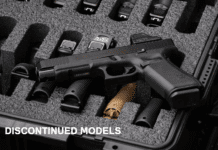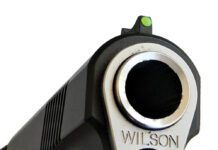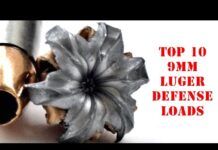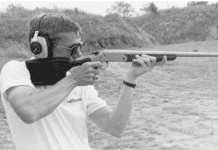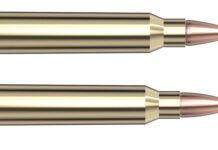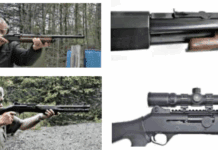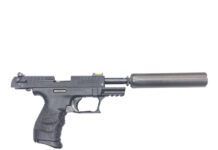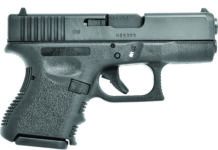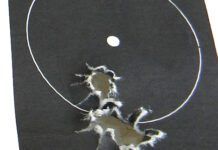Many of us believe we can shoot tight, tight groups with our off-the-rack rifles, and we brag about how “small” we are—perhaps the only time other than when we compare cell-phone sizes that we make such a claim. But the reality is that unmodified guns we purchase over the counter rarely shoot inch-or-smaller groups at 100 yards, and those of us who take our medication regularly secretly know that.
But we’ve found a class of affordable factory-production guns whose accuracy out of the box would not embarrass us when chuckin’ bullets at woodchucks or cutting cloverleafs on targets. A family of heavy-barrelled bolt guns, including Ruger’s KM77VT MKII Target Rifle, Remington’s Model 700VS Varmint Synthetic, Winchester’s Model 70 Synthetic Heavy Varmint, and Tikka’s Continental Varmint Rifle are all legitimate sub-inch guns when you first pull off their plastic wrappers. Recent testing we conducted with this trio of .223s showed remarkable accuracy with production .223 Remington ammo, which could likely be improved further with the addition of specialized handloads and case prep.
Of the set, we preferred the Winchester Model 70 Synthetic Heavy Varmint, $764, but the margin between the guns was narrow. The edge: We liked the Winchester’s flat forend and internal design better than the other guns. The $718 Ruger KM77VT MKII Target Rifle, the $705 Remington Model 700VS Varmint Synthetic, and the $694 Tikka Continental Varmint Rifle all shot half-inch groups with at least one ammo brand we used. That fact alone shows how much production-rifle accuracy has advanced, in our view, and it made picking a winner in this match-up difficult.
How We Tested
All range accuracy data was collected at 100 yards using a Ransom Master Rifle rest set on a solid concrete bench. Accuracy data were compilations of five three-round groups shot with Hornady’s 55-grain V-Max, Winchester 50-grain Silvertips, PMC 55-grain hollow-point boattail bullets, and Federal’s 69-grain hollow-point boattail load. We collected data from 10-shot strings to compute the chronograph readings. We used an Oehler 35P at 10 feet to record velocities. We cleaned the guns with Pro-Shot Copper Solvent between lots, then fouled between each load tested.
One of the first questions we asked ourselves was how much better the synthetic stocks would shoot than the wood-stocked guns, but we’re not sure that was a valid bias to hold, based on the actual outcome. Not every company makes a full range of metal finish/stock material options in this niche; for instance, the Ruger and Tikka wood-stocked guns are those companies’ only offerings in this heavy-barrel class, and though we did see some differences in accuracy, both guns shot well enough to earn recommendations, if based on just that factor. Otherwise, viewed for use as varminting guns, they matched up well in terms of barrel length (26 inches), weight (around 10 pounds), and stock design (straight butt).
Here are the specifics about how each varmint gun performed in our tests.
Winchester Model 70 Synthetic Heavy Varmint
Our recommendation: For pure accuracy, this is the winner. With a better trigger, it’s a world-beater.
Our Winchester Model 70 Synthetic Heavy Varmint test gun was the priciest gun in the test at $764. The classic stock design, similar to the Remington’s, also included pillar bedding and a full-length aluminum block, machine-cut to fit the receiver, and built into the stock. Winchester calls this the Pillar Plus Accu Block bedding system, and it includes glass bedding around the front and rear stock screw area of the receiver. The charcoal-grey composite stock had a 2.5-inch beavertail forend with a flat bottom. This improves stability and repeatability on the rest, where free recoil is important. This means the gun sits free in the rest and is allowed to recoil on its own when firing. Under ideal recoil conditions, the gun will move straight back with minimal disturbance in the sight picture. The flat forend keeps the gun upright during recoil, and after the shot, the shooter simply pushes the gun forward into the rest, where a stop on the Ransom Rest ensures the gun starts in the same position.
The Winchester’s overall accuracy groups averaged 0.49 inches with four test ammunitions. This overall group average was 0.07 inch better than the Remington’s tally. Our best group average with this test gun came with PMC’s 55-grain HPBT bullet: 0.38 inches.
The Winchester’s two-tone metal finish made this a good-looking firearm. A satin stainless steel finish on the gun’s 26-inch free-floated barrel contrasted nicely with the blued receiver. At 10 pounds 4 ounces, this was the heaviest of the test guns. A 0.87-inch-thick muzzle diameter accounted for the extra weight.
Compared to the other guns, the Winchester’s trigger pull was disappointing. It broke crisply at 4.5 to 4.75 pounds and showed a little creep. This trigger is somewhat adjustable, but it will have to be broken down and honed to get a lighter, smoother pull. The receiver is drilled and tapped and accepted Weaver bases and rings.
Tikka Continental Varmint Rifle
Our recommendation: Worth a look. This $694 gun shot under an inch with most ammo brands, but it wasn’t as accurate as the others with the brand/lots we shot. However, its interesting features might offset the accuracy disparity.
The Tikka’s overall accuracy groups averaged 0.96 inch, with three of the four test ammunitions shooting sub-1-inch groups at 100 yards. These stellar accuracy readings derive from the gun’s heavy barrel, the muzzle OD of which measured 0.770 inch at the crown, with a slight taper on the 26-inch free-floated barrel. An inspection of the gun’s bore with a Hawkeye 17-inch borescope showed no anomalies that would hinder accuracy. The gun’s trigger pull was crisp at 2.5 to 2.75 pounds, and it showed a little creep. The trigger could be adjusted for pressure only. The stock on this gun included a palm swell and hand-finished, diamond-point machine-cut checkering. However, the Tikka’s wood was closed grain, and had a matte-lacquer finish with a soft sheen. Wood-to-metal fit was excellent. The barrel had a low-gloss finish, while the receiver had a satin nonglare finish. The trigger guard and detachable three-round magazine were plastic. Using plastic for these parts, in our opinion, takes away from the appearance of the gun. Standard swivel studs were included.
The Tikka also had a two-position, tang-mounted safety on the right side. The receiver was drilled and tapped to accept Weaver bases and is also milled for Sako-style integral base and rings. Bolt operation was smooth as silk and showed flawless operation.
The stock’s length of pull was 14.25 inches with a 0.25-inch black-rubber buttpad. The buttpad allowed the shooter to change the length of pull and pitch angle by changing out butt spacers, which allows the shooter to adapt the gun to his own conformation—an advantage lacking on the other models.
Ruger KM77VT MKII Target Rifle
Our recommendation: The $718 Ruger KM77VT MKII Target Rifle shot accurately and had a great trigger. We’d buy it.
Three of the test ammunitions shot in the Ruger produced half-inch-or-smaller average groups at 100 yards, with the best group average of 0.42 inch coming from PMC’s 55-grain bullets. Only the Federal 69-grain boattail hollow-point round didn’t shoot well. We also liked the gun’s trigger pull, which drew a crisp 4 to 4.25 pounds out of the box. However, this trigger was adjustable, so we dropped the trigger-pull weight easily and quickly to 2 pounds. In our view, this feature gave the Ruger a leg up on the other guns. Of course, if you’re not familiar with trigger operation, you shouldn’t modify the release weight or sear engagement.
The Ruger KM77VT Target had a full-bull barrel that gently tapered to a muzzle OD of 0.730 inches. All metal on our test gun was stainless steel with a matte target grey finish overall. The laminated hardwood stock had a nonglare satin finish and very good wood-to-metal fit, but no checkering at the grip or on the forend.
The barrel was set slightly to the left in the stock channel, but was free floated with no bedding. Pillar bedding is needed with this wood stock, in our opinion. Temperature and humidity can quickly affect wood and cause movement of the action within the stock. The stock’s 13.5-inch length of pull included a 0.5-inch-thick black-rubber buttpad. Quick-detachable swivel studs are included. The fore-end has a 2.5-inch-wide beavertail bottom with a slight curve that worked very well in our rifle rest. The gun measured 46 inches in overall length and weighed 10 pounds without scope or rings. Ruger’s integral scope-mounting system made adding a Leupold 36X scope easy and saved us the additional cost of bases and rings.
A three-position rear tang safety was smooth and easy to work with the right thumb. The safety will lock the bolt and trigger when in the rear position. The middle position allows the bolt to open while the trigger remains locked.
Remington 700VS Varmint Synthetic
Our recommendation: This gun was superbly accurate, but it lacked a flat forend, which is a great help when shooting off a bench.
Our $705 Remington 700VS Varmint Synthetic test gun came outfitted with a dark-textured DuPont Kevlar composite stock. The classic straight-stock design included a machined one-piece aluminum frame, milled to fit the bottom of the receiver. This metal-to-metal design, strengthened with pillar-style action screws, made this stock weather-resistant and reliable. However, glass bedding around the receiver and screws might improve accuracy further.
The most important performance feature on the Remington was its superb accuracy. The 700VS averaged 0.56-inch-groups across four test ammunitions—remarkable considering the variation in brands and bullet styles. Our best group average (0.43 inches) with this test gun came with the Hornady V-Max 55-grain bullet.
The gun’s trigger broke crisply at 4.75 to 5 pounds and showed very little overtravel. To make the trigger more suitable for benchrest shooting, we adjusted it down to 2 pounds and could have gone lower. The gun measured 46 inches in overall length, 26 inches of which was in the barrel. The receiver was drilled and tapped and worked well with Weaver bases and rings, which we supplied. The gun weighed 9 pounds 10 ounces without a scope.
Metal on the barrel and the receiver’s metal were blued steel with a black matte finish. The muzzle diameter was 0.61 inches; the barrel widened as it moved toward the receiver.
The 700VS’s forend bottom was 1.75 inches wide and rounded, which was a little harder to settle into our rifle rest. The stock’s length of pull measured 13.5 inches. There was no checkering on the gun, nor was it needed. The synthetic stock produced a sufficient grip surface. The butt had a 0.25-inch-thick black-rubber pad. Sling swivel studs were standard, but we found that removing the front stud worked better when shooting off a rest.
Gun Tests Recommends
We can only wonder how well fine-tuned reloads would shoot in these guns. Though the Winchester shot the best overall, a close reading of the accuracy data shows that with the right ammo, each gun shot groups right at 0.50-inch averages. In our experience, this is unusual. Often, the best gun in a test will outshoot the others with nearly every brand of ammo, which makes picking an accuracy winner easy. Our results this time suggest that these guns are superbly accurate with the right load, and their downrange performance is only limited by the shooter’s ability to pick a good lot of factory ammo or tune a handload for them. Thus, we feel compelled to make our buying recommendation based on features, flexibility, and price.
We think the Tikka’s lack of glass bedding or a bedding block may have made the difference in relative accuracy. We think that if the gun was pillar bedded, as the Remington and Winchester guns were, and shot with fine-tuned reloads, results would be drastically improved. The Tikka Continental Varmint Rifle, $694, came in last in the accuracy rankings, but it also brought a list of impressive features: a partially adjustable trigger, good checkering, palm swells, adjustable buttpads, integral scope mounts, and free-floated barrels. If one of these features is a deal maker for you, you might want to look at the Tikka.
The $718 Ruger KM77VT MKII Target Rifle has a benchrest-shaped laminated stock and good trigger. We believe the gun still needs glass-bedding and pillars to realize its full accuracy potential.
The $705 Remington 700VS Varmint Synthetic features a topnotch bedding system the Ruger lacks, but its stock shape wasn’t as appropriate for off-the bench shooting. Also, though the Remington trigger is adjustable, the shooter must know his way around the trigger in order to modify it properly. A safer bet is to employ the talents of a trigger-savvy gunsmith, we think.
The Winchester Model 70 Synthetic Heavy Varmint narrowly outshot the others, has a forend design built for bench shooting, and has a solid structural underpinning, including a bedding block and a glassed-in action. These features justify its $764 price, and even needing trigger work, it’s our first pick.



